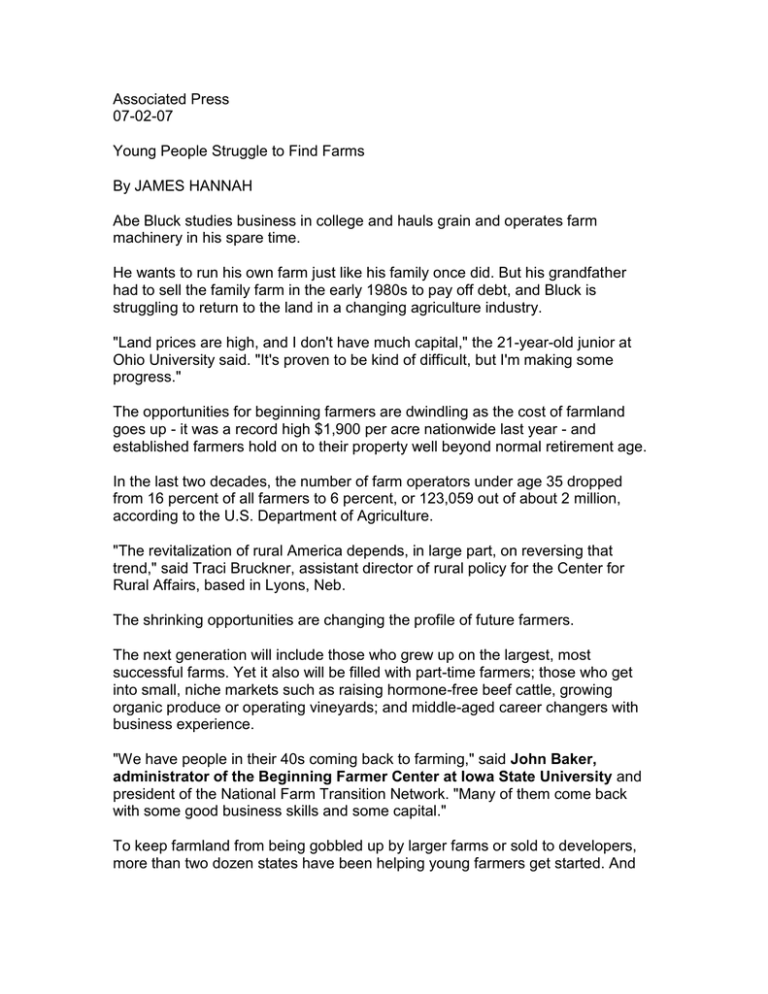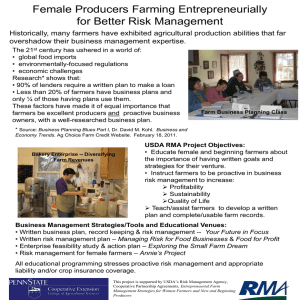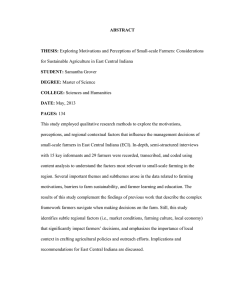Associated Press 07-02-07 Young People Struggle to Find Farms
advertisement

Associated Press 07-02-07 Young People Struggle to Find Farms By JAMES HANNAH Abe Bluck studies business in college and hauls grain and operates farm machinery in his spare time. He wants to run his own farm just like his family once did. But his grandfather had to sell the family farm in the early 1980s to pay off debt, and Bluck is struggling to return to the land in a changing agriculture industry. "Land prices are high, and I don't have much capital," the 21-year-old junior at Ohio University said. "It's proven to be kind of difficult, but I'm making some progress." The opportunities for beginning farmers are dwindling as the cost of farmland goes up - it was a record high $1,900 per acre nationwide last year - and established farmers hold on to their property well beyond normal retirement age. In the last two decades, the number of farm operators under age 35 dropped from 16 percent of all farmers to 6 percent, or 123,059 out of about 2 million, according to the U.S. Department of Agriculture. "The revitalization of rural America depends, in large part, on reversing that trend," said Traci Bruckner, assistant director of rural policy for the Center for Rural Affairs, based in Lyons, Neb. The shrinking opportunities are changing the profile of future farmers. The next generation will include those who grew up on the largest, most successful farms. Yet it also will be filled with part-time farmers; those who get into small, niche markets such as raising hormone-free beef cattle, growing organic produce or operating vineyards; and middle-aged career changers with business experience. "We have people in their 40s coming back to farming," said John Baker, administrator of the Beginning Farmer Center at Iowa State University and president of the National Farm Transition Network. "Many of them come back with some good business skills and some capital." To keep farmland from being gobbled up by larger farms or sold to developers, more than two dozen states have been helping young farmers get started. And bills are pending in Congress that would provide $25 million a year in grants to train and mentor beginning farmers and ranchers and help them get credit. Operating in 25 states, the National Farm Transition Network pairs beginning farmers, often young, with established farmers on the verge of retirement. The matchmaking gives young farmers a chance to get into farming without having to spend a lot of money, to avoid financially fatal rookie mistakes, and then come up with a financial arrangement that allows them to take over the farm. Some matchmaking programs are designed simply to get a novice started in farming, not necessarily to take over the farm of a mentor. Caterer Amy Forrest, 43, wants to grow lettuce, cabbages and other vegetables for a living on the family farm near Mechanicsburg. Her mentor, Guy Ashmore, 48, who raises vegetables, poultry and cattle near Wilmington, has visited to advise her how to lay out crops and which ones are best to start with. He has shared his records with her so she knows how much money she can expect to make. The biggest benefit so far? Ashmore helped her set up a computer program to keep track of the business. "It's fun to grow stuff, but you've got to figure out if you're making money at it," Forrest said. The Beginning Farmer Center in Iowa, which is part of the transition network, has arranged about 150 matches since it began in 1991 and 14 matches in the past seven months. Attorney Paul Wright, a former agricultural law professor at Ohio State University, has counseled farmers since the 1960s about how to pass on their farms. He said it is hard to match up farmers with someone not related to them. "I've seen it blow up," he said. "You have to match personalities and business objectives and financial feasibility, which is very difficult to do." Along with pairing novices with old hands, Connecticut - where dairy, corn, tobacco and flowers are major crops - has spent $30 million over the past 11 years in its Farmland Preservation Program to buy the development rights of 70 farms totaling 10,000 acres. That makes it more affordable for beginning farmers, keeping the value of the land as much as 80 percent cheaper than if it were opened for development. Over the past 12 years the Wisconsin School for Beginning Dairy and Livestock Farmers - sponsored by the University of Wisconsin at Madison - has taught more than 200 students how to start a dairy. Many of the students - who learn how to develop a business plan and design a milking center - didn't grow up on farms. And many don't know how to run a business, a key skill. "A lot of young people just want to see diesel smoke," said program coordinator Dick Cates. While these programs have helped some young people get started, the number represents a fraction of those farming. For many new farmers, the only way in is by taking over for a relative with an existing farm. But it's not unusual for farmers to discourage their children from going into the business - citing high land prices, long hours, low wages and living in isolation. At the same time, young farmer wannabes looking for land often get the cold shoulder from established farmers, who want to keep the property in the family. "Because you work on it, you get attached to it," said Richard Sweeney, 72, who raises beef cattle on 30 acres near this central Ohio village. "I would hope it stays in the family." Sweeney has two sons and a daughter - all grown and with their own families. His sons don't want to work the farm, and his daughter hasn't decided. "They've all got good jobs," Sweeney said. "I wanted one of them to take it over, but we never decided which one would do it." Bluck is trying to break into the business by renting and working a little farmland and then saving his money in hopes of buying his own farm. But the dwindling number of opportunities for beginning farmers means some simply won't make it. Nathan Douridas, 28, of Columbus, received an associate degree in crop management, then spent six years with a Clark, S.D.-based combine crew that harvested wheat from Texas to the Canadian border. He was given the chance to farm 100 acres in South Dakota and then 200 but had to return to Ohio for family reasons and doesn't have the money to buy a farm. "That's the opportunity I had been looking for," Douridas said. "It's just unfortunate it was in eastern South Dakota, a thousand miles away from my family."




